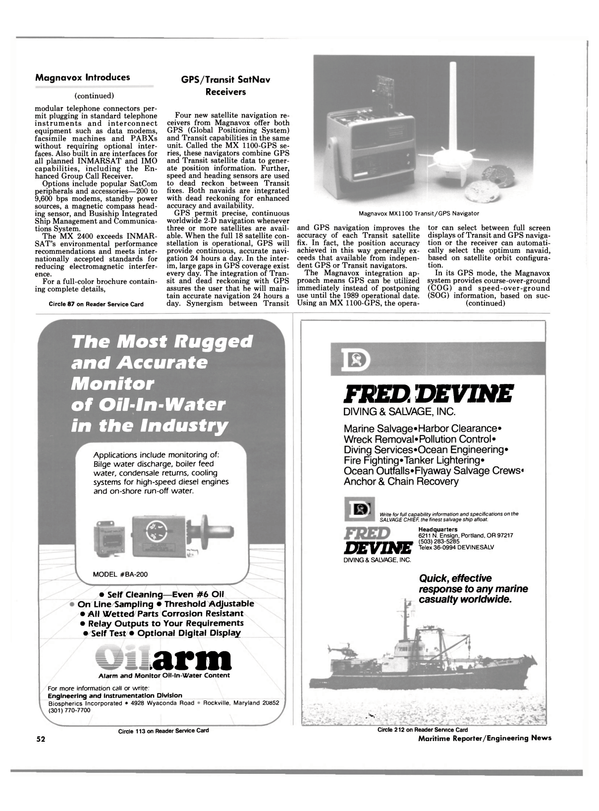
GPS/Transit SatNav Receivers
Four new satellite navigation receivers from Magnavox offer both GPS (Global Positioning System) and Transit capabilities in the same unit. Called the MX 1100-GPS series, these navigators combine GPS and Transit satellite data to generate position information. Further, speed and heading sensors are used to dead reckon between Transit fixes. Both navaids are integrated with dead reckoning for enhanced accuracy and availability.
GPS permit precise, continuous worldwide 2-D navigation whenever three or more satellites are available.
When the full 18 satellite constellation is operational, GPS will provide continuous, accurate navigation 24 hours a day. In the interim, large gaps in GPS coverage exist every day. The integration of Transit and dead reckoning with GPS assures the user that he will maintain accurate navigation 24 hours a day. Synergism between Transit and GPS navigation improves the accuracy of each Transit satellite fix. In fact, the position accuracy achieved in this way generally exceeds that available from independent GPS or Transit navigators.
The Magnavox integration approach means GPS can be utilized immediately instead of postponing use until the 1989 operational date.
Using an MX 1100-GPS, the operator can select between full screen displays of Transit and GPS navigation or the receiver can automatically select the optimum navaid, based on satellite orbit configuration.
In its GPS mode, the Magnavox system provides course-over-ground (COG) and speed-over-ground (SOG) information, based on suc- cessive 1.6 second position computations.
Real-time set and drift information is also displayed using the vector difference between COGs and SOGs, and the ship's measured speed and heading through the water.
The system has a two-channel receiver, for continuous GPS usage.
While the first channel sequentially tracks each selected satellite, the second searches for and selects future optimum satellites.
The Magnavox approach emphasizes maximum availability. To optimize the GPS use with the presently limited constellation, the MX 1100-GPS can provide two-satellite navigation, delivering a more precise continuous running fix. This technique minimizes the accumulation of dead reckoning error between either three-satellite GPS or Transit fixes.
Magnavox has designed these receivers for optimum navigation performance today and for a smooth transition to the future. The MX 1100-GPS lets the owner continue working with the familiar Transit system while learning GPS. As more GPS satellites are launched, the receiver takes full advantage of the expanded constellation. Ultimately, and without operator intervention, the Magnavox system will navigate totally on GPS satellites using Transit as a backup system. (The Transit system will remain in operation until at least 1994.) The new SatNav series is available in either of four models, including single and dual-channel Transit Satellite and Omega capabilities. In addition, an upgrade package consisting of easily installed electronics boards and antenna is offered as a GPS field retrofit for existing Magnavox MX 1102, MX 1112, MX 1142, MX 1105, MX1107, and MX 1157 Transit SatNavs.
For full-color brochures containing complete information, Circle 88 on Reader Service Card
Read GPS/Transit SatNav Receivers in Pdf, Flash or Html5 edition of December 1985 Maritime Reporter
Other stories from December 1985 issue
Content
- United States Cruises Applies To M a r A d For $150-Million Title XI page: 4
- PA Series Heavy Fuel Diesel Now Available From Fairbanks Morse page: 6
- Six-Page Color Brochure On Energol Lubricants Offered Free By BP Marine page: 6
- Getty Fleet Orders Lips Speed-Adapted Propellers To Increase Efficiency page: 6
- Karl Senner Offers Free Color Brochure On Reintjes Marine Gearboxes page: 6
- OMSA Elects New Officers —Congressman Warns Of California Plan' page: 8
- Birka Line Cruise Ship Launched At Valmet's Helsinki Shipyard page: 8
- Fire Combat, Inc. Offers 10-Page Manual On Fire Suppression Systems page: 9
- Texaco Appoints Quegan General Manager, Marine Department page: 10
- Fernstrom Elected President And CEO Of American Ship Building page: 10
- New Briefcase Computer For Marine Industry From NAV-COM page: 12
- Furuno USA Introduces New Doppler Speed Log And ARPA Line page: 12
- W. Anthony Watt Heads Sales And Marketing Division At Moran Towing page: 14
- Marinette Delivers First Of Ten Torpedo Weapons Retrievers page: 14
- Bassett Named President Of Interocean Management page: 14
- Kockums To Build Ferry With First Coal-Fired Marine Steam Engines In 30 Years page: 16
- COSCO And McMullen Form New Company— COSCO North America page: 17
- Cunard Gives $115-Million Contract To Lloyd Werft To Convert QE2 To Diesel And Alter Accommodations page: 17
- Harnischfeger To Build World's Largest Dipper/Clamshell Dredge page: 18
- Bethlehem Steel Dedicates Its New Sabine Yard In Port Arthur, Texas page: 18
- Totem To Acquire Controlling Interest In Interocean Steamship Corp. page: 20
- OUTSTANDING OCEANGOING SHIPS OF 1985 page: 22
- NOTABLE CONVERSIONS OF 1985 page: 44
- Bender Shipbuilding Wins $4.5 Million In Contracts page: 49
- Construction of 'Theodore Roosevelt' Ahead Of Schedule And Under Budget page: 50
- Magnavox Introduces New Generation SatCom And New GPS/Transit SatNav Receivers page: 51
- GPS/Transit SatNav Receivers page: 52
- Network 90, Integrated Marine Management System For Reduced Costs And Maximized Profits page: 55
- SHIPBOARD COMPUTER SURVEY page: 58
- Ellicott Machine Corporation Announces Personnel Changes page: 68
- Vapor Corporation Announces New Sphere Matrix Technology page: 68
- U.S. NAVY SHIP PROCUREMENT Second Quarterly Update—November 1985 page: 70
- MSI Conducting Tests For Proposed Canadian Ferry With Voith Schneider Propulsion page: 77
- Design Improvements In EMD's 645FB Diesel Provide Higher Horsepower, Better Fuel Economy page: 78
- Perko Presents The 200 Series International Navigation Lights page: 81
- Coast Guard Completes Installation Of Advanced Navigational Aid In N.Y. Harbor page: 85
- Macmeter Offers Metering Protection page: 91
- MARDATA Named North American Agent For Lloyd's Information Services page: 91


